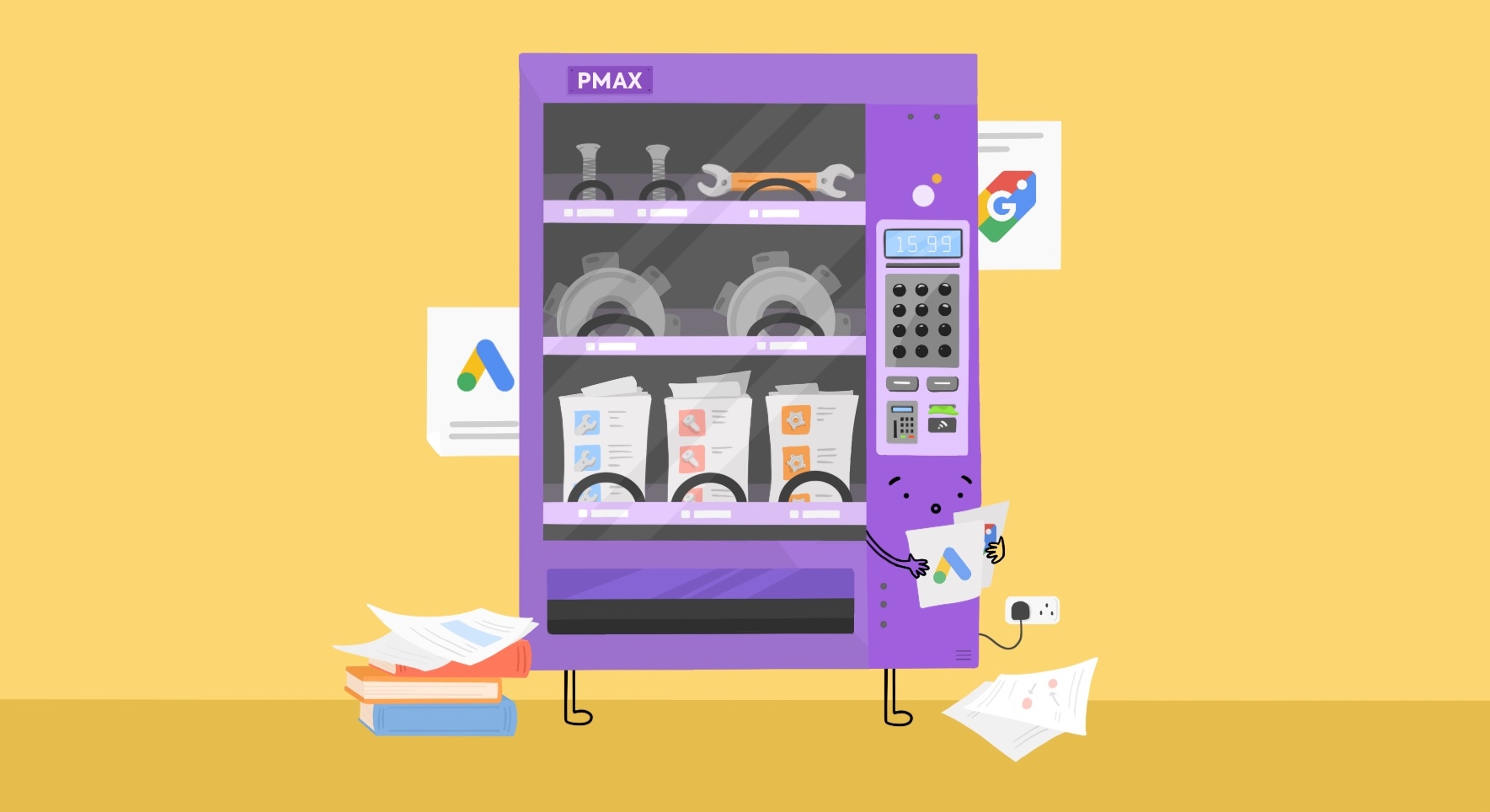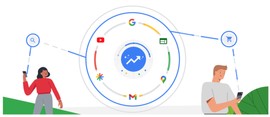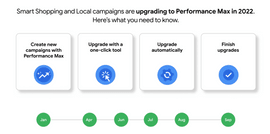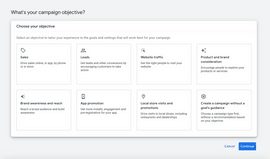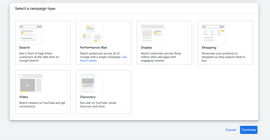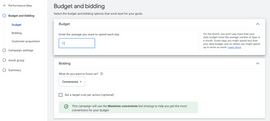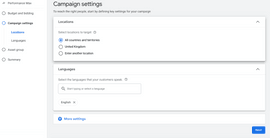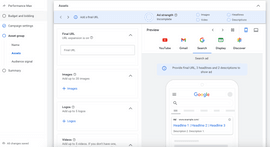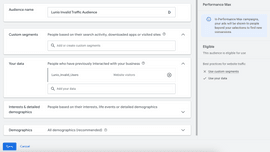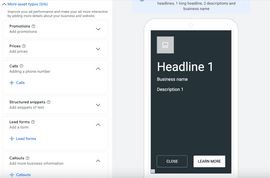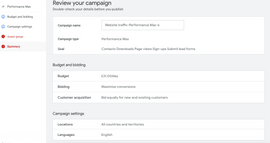If you’re a marketer you’ve probably heard the name a few times already. But what is Performance Max (PMax)?
How does it work? And why are more and more PPC pros spending aggressively on it? This post will get you up to speed on the fundamentals of Google’s new automated campaign type. Expect to learn:
- What Performance Max actually is (in plain English)
- A complete timeline leading to the introduction of PMax
- When it makes sense to use Performance Max
- How PMax differs from Smart Shopping campaigns
- The inputs and controls for PMax campaigns
- How to set up your own Performance Max campaign
- What PMax means for marketers
- What the future of PPC automation looks like
Performance Max launched to all advertisers in November 2021. And since then, increasing numbers of brands have had a chance to see it in action for themselves. But does it live up to the hype and optimised campaign performance promised by Google?
To find out, we worked closely with Google Ads specilaists Bob Meijer and Miles McNair to create The Expert Guide to Performance Max (which you can download in full for free – no email required!).
Combined, Bob and Miles have over 10 years of PPC experience, worked for more than 200 clients, and profitably spent over €100M on Google Ads. Unlike agency owners or ‘gurus’, the pair actually manage Google Ads campaigns every single day. And everything they teach is based on real, practical experience.
This blog marks the first in a series of posts where we’ll unpack key insights and takeaways from the guide to help you build, optimise, and scale highly profitable Performance Max campaigns. So let’s dive in.
What Is Performance Max?
Performance Max is Google’s new goal-based campaign type that (surprise surprise), focuses on maximising performance. Specifically, it uses machine learning and AI to optimise your campaigns with the aim of increasing your overall conversion volume.
One of the biggest selling points of Performance Max is it allows you to run ads across the entire Google Network from a single campaign. That includes Search, Shopping, Gmail, YouTube, Maps, Discovery, and Display.
It also promises to deliver “deeper” and “more useful” campaign insights thanks to its machine learning engine and upgraded reporting capabilities (but there are some issues here, more on that later in the series).
It’s very much a “black box” system. You set your inputs. The algorithm does its thing. And (hopefully) conversions materialise at the other end. Currently, you don’t even know where your ads are showing up or to whom. But there’s more than enough evidence now to show that Performance Max delivers real results when calibrated correctly.
Before we move on, it’s worth noting that Performance Max is still in its infancy. So it’s not perfect. But it’s already much better than when it was first launched in November 2021. And Google is releasing new small updates and improvements every week.
Whether you like it or not, it’s clear increased automation is the new direction for PPC. So now is the time to learn how to leverage this new system to get the best results.
The Timeline to Performance Max: How Did We Get Here?
Starting back in 2010, Google has been encouraging advertisers to adopt its ever-growing array of automated features. So here’s what the progression and advancement looks like to date.
2010 – Google first introduced Enhanced CPC bidding back in 2010, it dynamically adjusted campaign bids for keywords and ads that Google thought were more likely to convert.
2016 – Google Ads introduced Smart Bidding strategies, building on the capabilities of previous automated bidding options such as enhanced CPC
2018 – Google launched Smart Shopping campaigns (formally known as Universal Shopping Campaigns) to automate the bidding process based on your chosen strategy.
2018 – Responsive Search Ads (RSAs) were introduced by Google as a way to help advertisers find the winning combination of headlines and descriptions for effective text ads.
2019 – Google launched automated Local Campaigns to help businesses promote their brick and mortar shops to potential customers across Search, Maps, YouTube, Gmail and Display.
November 2021 – Google launched Performance Max to all advertisers to help them drive better results across all Google Ads channels and inventory.
January 2022 – Google announced it will automatically transition existing Smart Shopping campaigns into Performance Max campaigns between July and September 2022.
September 2022 – All Smart Shopping & Local Campaigns were migrated to Performance Max (with the exception of a few larger retailers who needed more time to complete migration).
When Should You Use Performance Max?
According to Google’s documentation, PMax is the best option to use when:
- You have specific advertising and conversion goals (for example, driving online sales, lead generation, and others). When it comes to setting goals, Miles stressed the importance of having a firm grasp of your numbers:
What is your break even ROAS? What is your break even cost to acquire a new customer? Is your first sale more valuable because you can upsell more on the backend? Or is your first sale typically less valuable than the ones that follow? These are the kinds of questions you need answers to. If you know your numbers inside out, you can translate them into concrete goals within your Performance Max campaign.
- You want to maximise the performance of your campaign, and you aren’t limited by which channel your ads appear on. If your ads have constraints (i.e. budget or lack of resources) or they were created for one specific channel, Performance Max won’t deliver optimal results. It works best for flexible campaigns that you can tweak and refine over a period of weeks and months.
- You want to easily access all of Google’s advertising channels using a single campaign. As mentioned previously, that includes Search, Shopping, Gmail, YouTube, Maps, Discovery, and Display.
- You want to get additional reach and conversion value beyond keyword-based Search campaigns. Performance Max was designed to help you target relevant audiences across all channels, making it easier to acquire new customers than through Search alone.
Performance Max vs Smart Shopping
As documented in the timeline above, Performance Max has now fully replaced Smart Shopping. But what are the key differences between these two campaign types? And what improvements should you expect to see after making the transition?
According to testing conducted by Google, advertisers who upgrade Smart Shopping campaigns to Performance Max see an average increase of 12% in conversion value at the same or better return on ad spend (ROAS). This uplift in conversion value is due to two main differences between the campaign types:
1. Performance Max replaces Smart Shopping’s ad and product groups with “asset groups” which form the core of all campaign activity. Asset groups are a collection of different creatives including text, images, logos, links, videos, and more. PMax automatically mixes, matches, and tests different combinations of these to hone in on those that convert best.
2. Performance Max adds additional placements and reach. It essentially puts your ads in front of new (and often untapped) audiences across Display, Discovery, Gmail, YouTube, Maps and more.
In a nutshell, PMax creates better performing ads and puts them in front of a wider range of relevant audiences.
What’s Happening to Standard Shopping?
While Smart Shopping is gone, Google have confirmed Standard Shopping campaigns will remain “for the foreseeable future”. Running a Standard Shopping campaign may be more appropriate in certain (albeit less common) circumstances, for example:
- If you have a really limited budget.
- If you’ve tried Search in the past and didn’t work well.
- Google Shopping is your only genuinely profitable channel.
Performance Max for Lead Gen
Unlike Smart Shopping, Performance Max can also be used for lead generation, delivering scale and efficiency that may be hard to achieve through Search and Display alone. But you need to feed the algorithm the right signals so you don’t end up with poor-quality leads (more on this later).
Overall, PMax is currently better suited for B2C campaigns. It takes more work to set up a B2B campaign that consistently delivers relevant, high-quality lead submissions.
What Inputs Does Performance Max Use?
The inputs for Performance Max campaigns include:
- Campaign objectives – Performance Max is a goal-based campaign type, so getting your initial objective selection right is one of the most important parts of the process. These include driving sales, leads, website traffic, brand awareness, app promotion and more.
- Audience signals – This new feature lets you suggest audiences you think have the highest likelihood of conversion to Google’s machine learning algorithms. Providing relevant data-based audience signals helps steer your campaign in the right direction (more on this later).
- Creative – The ad copy, images, logos, and videos in your asset groups are vitally important. If your creative is poor quality or doesn’t resonate with your target audience, better automation won’t do much to help you. Performance Max can get your ads in front of the right people, but the creative itself needs to drive the conversion.
- Conversion goals – Only input conversion goals that you know drive tangible value for your business. Be sure to remove non-essential goals such as tracking newsletter signups. Otherwise the algorithm will end up optimising for low-value outputs.
- Safety settings – This was made with brand managers in mind as you can specify the types of content, placement, and inventory where you DON’T want your ads running. Account-level negative keywords will soon be available and can be used to exclude certain search terms from your Performance Max campaigns.
What Controls do Performance Max Campaigns Have?
When it comes to tailoring Performance Max to best fit your needs, there are quite a few options available including:
Budget – After determining your conversion goals, set your budget accordingly.
Bidding strategy – The available bidding strategies are limited. You can only select to Maximise Conversions (with optional target CPA) or Maximise Conversion Value (with optional target ROAS).
Location – Specify where you’d like your ads to run.
Language – What language is your campaign targeting?
Ad scheduling – Choose your schedule and when you’d like your campaign to run.
URL options – Choose whether you want Google to send traffic to what it deems to be the most relevant URLs on your site, or if you want traffic sent to only the URLs you specify.
Asset groups – These are essentially your ads. They’re easy to set up – simply provide the creative (i.e. logos, videos, headlines, etc.) and Google does the rest.
Audience signals – These allow you to refine the automated targeting process.
Ad extensions – Choose whether to use existing sitelink extensions or create sitelinks specific to your campaign.
How to Set Up a Performance Max Campaign
Follow the 8 steps below to get your first PMax campaign up and running:
Step 1: Choose Your Objective
Step 2: Choose Performance Max Campaigns
Step 3: Determine Budget and Bid Strategy
Step 4: Campaign Settings
Step 5: Create an Asset Group
Step 6: Input Your Audience Signals
Step 7: Create Ad Extensions
Step 8: Review Your Campaign Summary
What Does Performance Max Mean for Marketers?
Performance Max automates a lot of the time-consuming, manual work of setting up campaigns across different platforms. The only thing you have to do is provide inputs, then monitor and adjust the campaign as automation does its thing to help you achieve your campaign goals. So in that regard, it frees up time for marketers to spend on other things.
But it’s important to note that you can’t simply “set and forget” a Performance Max campaign. Without human oversight, there’s a real risk of significantly overspending, or being flooded with a deluge of low-quality leads. But that aside, it does lower the bar to entry. You don’t need lots of specialist technical knowledge to run a profitable Performance Max campaign.
Performance Max essentially levels the playing field for all advertisers.
Will Performance Max Replace Human PPC Specialists?
In 2024 it’s highly likely that every business will be running Performance Max campaigns. So in that environment, how do you make sure you stand out? Is there anything you can do as an experienced PPC specialist to get the edge over your competitors? Here’s what Bob had to say:
For me, the automation of targeting and bidding means things like ad copy, image generation, and landing page optimisation are becoming even more important. I don’t think PPC specialists have to fear for their jobs. But the work they do in 2024 will be very different from what they’re spending most of their time on today. Personally I’m already starting to dive deeper into stuff like ad copywriting and conversion rate optimization (CRO). Because I think that will be a huge chunk of my work in the near future.
What Does the Future Hold?
It’s hard to say exactly where advances in machine learning will take us in the coming years. But current trends give some indication. For one, adoption and usage rates for Performance Max are expected to increase significantly, making it the default campaign type most marketers rely on.
Google is steering away from keyword targeting and keyword bidding as we know it, suggesting a move towards a “keywordless” future. That means attribution is going to become even more important, especially when you consider we’ll likely eventually lose third-party cookies too. We’ve already lost the original iteration of keywords because of things like close match variants and broad match. Exact keywords are not exact anymore. And that means marketers now need to put more focus on their creatives, offers, and the actual person behind the search
Drive More Profitable PMax Growth With Lunio
Want to get more value from your Performance Max campaigns?
Currently, Google doesn’t let you select which ad types to prioritise or audiences to exclude. And all too often, the system inflates ad spend by chasing junk traffic and leads that never translate into actual revenue.
That’s why Lunio generates exclusion audiences to protect your campaigns from fake clicks, zero-value traffic, and spam leads. Which instantly boosts PMax ad spend efficiency:
- Eliminate junk traffic pre-click and avoid wasted spend
- Uplift key performance metrics like your ROAS, CVR and CPA
- Prevent invalid data skewing the delivery algorithm
- Boost lead quality and sales efficiency by blocking fake form fills
- Gain more transparency over PMax traffic sources
Get a customised demo and free trial – no obligation to purchase.
Maximise Performance
Join our 14-day trial to engage genuine users and understand the potential of Performance Max.
